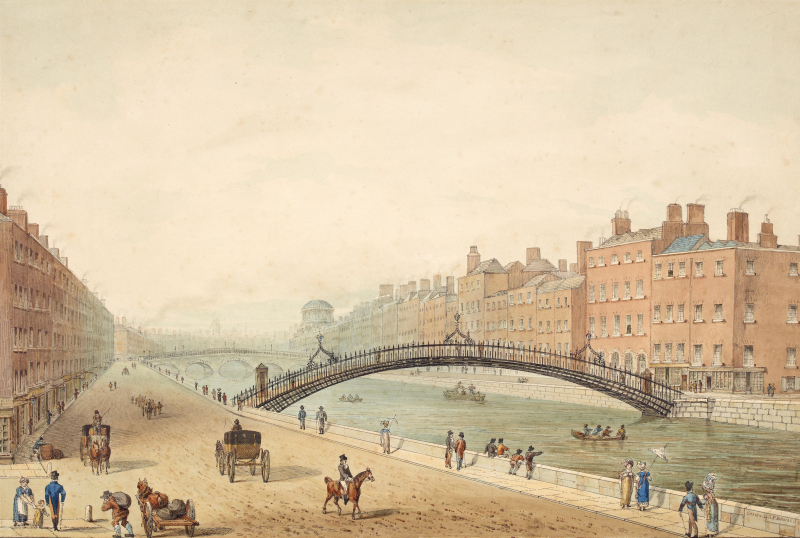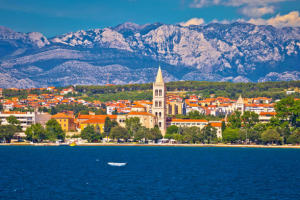Top 8 Reasons Why Ireland Has Fewer People Than 200 Years Ago
Ireland has seen its population decrease significantly over the past two centuries. In the early 19th century, Ireland’s population was at its peak, with a ... read more...total of 8.2 million people. However, by the end of the 20th century, this number had dropped to around 4.4 million. There are numerous factors that have contributed to this decline, ranging from high rates of emigration to political and economic turmoil.
-
The most apparent reason for Ireland’s population decline is emigration. As economic troubles or political unrest have hit the island nation, many people have chosen to leave in search of a better life elsewhere. In the 19th century, over one million people left Ireland for the United States. From the 1920s to the 1950s, another million fled the Irish Free State in the wake of civil war and economic depression. In the 21st century, emigration continues to be a major factor in the population decline, with an estimated 150,000 people leaving the country between 2011 and 2016.
In the 19th and early 20th centuries, Ireland was one of the poorest countries in Europe, with high poverty, disease, and malnutrition levels. The lack of economic opportunities in Ireland and the hope of a better life abroad led many Irish people to leave their homes and families and start a new life in other countries.
Emigration also continued to be a factor in Ireland's population decline in the 20th century. Many Irish people moved to other countries in search of work, and this trend has continued to the present day, with significant numbers of Irish people emigrating to other countries, particularly to the United Kingdom, the United States, and Australia.

Europeana on Unsplash RealLifeLore -
The Great Famine of the 1840s was a catastrophic event in Ireland's history that had a lasting impact on the country and its people. The famine, caused by a potato crop failure, led to widespread starvation and death and was a major factor in the decline of Ireland's population.
At the time of the Great Famine, Ireland was one of the poorest countries in Europe, and the potato was the staple food for much of the population. When the potato crop failed, people were left without a food source, and many died of starvation or related diseases such as typhus and cholera.
The Great Famine also led to mass emigration from Ireland, as people sought food and work in other countries. Over a million Irish people emigrated between 1845 and 1855, many of them to the United States, Canada, and Australia. This led to a significant loss of population in Ireland, and the country's population has never fully recovered from the effects of the famine.
In addition to the loss of life and population, the Great Famine had far-reaching consequences for Ireland and its people. The famine left a deep scar on the country's history and culture, and it has been remembered and commemorated in various ways, including through literature, music, and art.
In conclusion, the Great Famine was a major factor in the decline of Ireland's population over the past 200 years. The famine led to widespread death and emigration, and it has had a lasting impact on the country and its people. Despite these challenges, Ireland has continued to thrive and has become a modern and dynamic country with a rich cultural heritage.

Thought Catalog on Unsplash 
Steve Knutson on Unsplash -
The partition of Ireland, which officially occurred in 1921, had a profound impact on the population of Ireland. It was a constitutional change that had a lasting effect on the country’s demographics, resulting in fewer people in Ireland than 200 years ago.
Since the partition of Ireland, the population has decreased significantly. Although it is impossible to accurately calculate the exact population of Ireland in the early 1800s, it is estimated that it was likely around 8 million people. By 2021, the population of Ireland was estimated to be around 4.8 million people. This enormous population decrease can be attributed to several factors, including the increasing emigration of people from Ireland, the reduction in birthrates, and the effect of the partition of Ireland itself.
The partition of Ireland divided the country into two states, the Republic of Ireland and Northern Ireland. This split resulted in a number of political, economic and social issues, particularly between the two states. In terms of population, the partition of Ireland had a negative effect on the Irish people.
For instance, the partition of Ireland made it difficult for people to travel freely between the two states, resulting in many people being stranded on one side or the other. This meant that people could not settle in the other state, resulting in them either staying in their state or emigrating to another country. This was particularly the case during the Troubles, a period of conflict between the two countries. It is estimated that over 200,000 people were forced to flee their homes during this period. As a result, the population of Ireland was reduced significantly.
A Troubled Land 
Will Francis on Unsplash -
In the 16th and 17th centuries, religious conflict between Catholics and Protestants led to significant outflows of people from Ireland as those of a different faith fled persecution. This trend continued in the 18th and 19th centuries, as many Irish Catholics emigrated to other countries for religious freedom and economic opportunities.
Religious persecution has been a major factor in Ireland's population decrease. During the 19th century, the Protestant Ascendancy in Ireland sought to impose their religion on the country, leading to a rise in religious intolerance and persecution. This persecution led to a great number of people fleeing the country, and the population saw a significant decrease.
The religious persecution in Ireland also led to an increase in sectarianism. Sectarianism is defined as a form of discrimination based on religious beliefs. This form of discrimination meant that those of different religions were treated differently and, in some cases, violently. This led to many people leaving the country and searching for a more tolerant society, contributing to the population decrease.
The combination of religious persecution and sectarianism have all had an impact on the population decrease in Ireland. These factors have led to a large number of people leaving the country, leaving the population much lower than it was centuries ago. The population decrease in Ireland is a reminder of the importance of religious tolerance and the devastating effects of religious persecution.

K. Mitch Hodge on Unsplash 
K. Mitch Hodge on Unsplash -
Ireland has experienced a population decrease for the past two centuries for various reasons. One of the main reasons is the long-standing wars and military conflicts within the country. From the Great Famine of 1845-1849 to the Irish Civil War of 1922-23, numerous events have collectively reduced the population of Ireland.
The Irish Civil War lasted from 1922 to 1923. This conflict was fought between forces supporting the treaty that established the Irish Free State and those who opposed it. The conflict resulted in significant loss of life and displacement of people, and it profoundly impacted the country's political and economic stability.
Another significant conflict in Ireland's history was the Irish War of Independence, which lasted from 1919 to 1921. This conflict saw the Irish fighting for independence from the British Empire, resulting in significant loss of life and displacement of people. The conflict also led to the division of Ireland into Northern Ireland and the Irish Free State, which significantly impacted the country's demographic makeup.
In addition to these major conflicts, Ireland has also been affected by a number of other wars and military conflicts throughout its history. These events have contributed to the decline of the country's population over the past 200 years, as many people have been forced to flee their homes and emigrate in search of safety and stability.

Timon Studler on Unsplash 
ev on Unsplash -
Over the past two centuries, Ireland's population has decreased vastly due to political turmoil. From a population of over 8 million in the early 1800s, it now stands at only 4.9 million people. This steep population decline is due to several factors, including emigration, famine, and political unrest.
In the mid-1800s, Ireland suffered from extreme poverty and famine caused by a potato blight that destroyed the country's main food source. This resulted in mass emigration, with an estimated 1.5 million people leaving Ireland between 1845 and 1850. Many people who left Ireland during this time settled in the United States, where they could find better opportunities.
Political unrest has also been a major contributor to Ireland's population decline. During the Easter Rising of 1916, the Irish Republican Army (IRA) attempted to overthrow British rule in Ireland. Although the uprising was unsuccessful, it ultimately led to the Anglo-Irish War of 1919-1921, in which the British army fought against Irish nationalists. This conflict resulted in thousands of deaths and further emigration and displacement of people.
More recently, the Troubles in Northern Ireland led to increased sectarian violence in the region. The Troubles began in the late 1960s and lasted until the late 1990s, resulting in thousands of casualties and an exodus of people from the region. The conflict also led to economic hardship and poverty, which further discouraged people from remaining in Ireland.

ev on Unsplash 
Markus Spiske on Unsplash -
The Irish economy has played a significant role in the decline of Ireland's population over the past 200 years. Ireland has a long history of economic hardship, and economic factors have been a major driver of emigration from the country.
Throughout the 19th century, Ireland experienced economic hardship, with widespread poverty and unemployment. The country was heavily dependent on agriculture, and economic downturns in this sector devastated the population. The Great Famine of the 1840s was a particularly significant event, as the failure of the potato crop led to widespread starvation and death and was a major factor in the decline of Ireland's population.
In the 20th century, Ireland continued to experience economic challenges, particularly in the mid-century. The country's economy was primarily dominated by agriculture, and the lack of industrialization led to high levels of unemployment and poverty. Many Irish people emigrated to other countries in search of better economic opportunities, particularly to the United States and other parts of the world.
However, in the latter half of the 20th century, the Irish economy began to improve, and the country underwent a period of rapid economic growth and modernization. Several factors, including increased foreign investment, the expansion of the service sector, and the development of high-tech industries, drove this. Today, Ireland has a thriving economy and is known as a hub of innovation and entrepreneurship.

Darlene Alderson on Pexels 
gdtography on Pexels -
Public health in Ireland dates back to the 1800s when the country started to industrialize. Public health regulations were implemented during this period to protect citizens from diseases and other conditions. These regulations included initiatives such as introducing vaccination programs and water treatment facilities. At the same time, public health also worked to improve living conditions by providing sanitation systems, housing initiatives, and educational programs.
Unfortunately, these measures were not enough to keep the population of Ireland growing. In the early 1900s, the country experienced a famine, and the population dropped drastically. This was partly due to the lack of public health initiatives to prevent and treat disease. In addition, the population was hit hard by the Great Irish Famine of 1845-1852. This famine was caused by a potato blight that destroyed the vast majority of the potato crop, which was the staple food of the Irish population. With no other food source available, people starved to death or had to immigrate in search of food.
As the 20th century progressed, public health initiatives increased in Ireland. Vaccination programs were widely implemented, public housing was subsidized, and new sanitation systems were implemented. However, the population of Ireland continued to drop. This was partly due to the country’s high mortality rate caused by poor living conditions and lack of healthcare access. In addition, the country experienced many emigrants due to a lack of employment opportunities and poverty.

CDC on Unsplash 
Elizabeth McDaniel on Unsplash



























